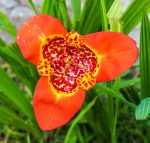 This tender perennial bulb is native to semitropical to semialpine climates of Mexico, Guatemala, El Salvador and Hondurus and is a member of the iris family, Iridaceae, that also includes crocus, gladiola, and and crocosmia. Other names include jockey’s cap lily, Mexican shellflower, peacock flower, tiger iris and Christ’s knee. Plants grow 1-2′ tall and have fan-like tufts of lance-shaped leaves. In mid to late summer brightly colored flowers 3-6″ across appear and consist of a spotted cup surrounded by 3 relatively small spotted petals and 3 larger petals in a single color. The colors range from scarlet, to orange, pink, yellow, mauve and white. Each flower lasts only one day, opening in the early morning and closing by dusk. Tiger flower is an excellent choice for beds, borders and containers. The Aztecs and indigenous people of North America roasted and ate the chestnut flavored edible bulb. The genus name, Tigrida, is from the Latin word tigris meaning tiger, referring to the spots on the petals and center cup. The specific epithet, pavonia, honors Spanish botanist and traveler in South America, Jose Antonio Pavon (1754-1840)
This tender perennial bulb is native to semitropical to semialpine climates of Mexico, Guatemala, El Salvador and Hondurus and is a member of the iris family, Iridaceae, that also includes crocus, gladiola, and and crocosmia. Other names include jockey’s cap lily, Mexican shellflower, peacock flower, tiger iris and Christ’s knee. Plants grow 1-2′ tall and have fan-like tufts of lance-shaped leaves. In mid to late summer brightly colored flowers 3-6″ across appear and consist of a spotted cup surrounded by 3 relatively small spotted petals and 3 larger petals in a single color. The colors range from scarlet, to orange, pink, yellow, mauve and white. Each flower lasts only one day, opening in the early morning and closing by dusk. Tiger flower is an excellent choice for beds, borders and containers. The Aztecs and indigenous people of North America roasted and ate the chestnut flavored edible bulb. The genus name, Tigrida, is from the Latin word tigris meaning tiger, referring to the spots on the petals and center cup. The specific epithet, pavonia, honors Spanish botanist and traveler in South America, Jose Antonio Pavon (1754-1840)
Type: Tender summer bulb, often grown as annual
Bloom: Brightly colored flowers 3-6″ across consisting of a spotted cup surrounded by three smaller spotted petals and 3 large petals in a single color ranging from scarlet, to orange, pink, yellow, mauve and white; mid to late summer
Size: 1-2′ H x 5″ W
Light: Full sun
Soil: Average, medium moist, well-drained
Hardiness: Zones 8-10
Care: Fertilize, water regularlly, and provide with dry winter dormancy by lifting bulbs in fall and storing in a dry place.
Pests and Diseases: Slugs, spider mites, viruses
Propagation: Seed, division of offsets
Companion Plants: Summer hyacinth, daylily
Outstanding Selections:
‘Alba’ (white flowers)
‘Aurea’ (yellow flowers)
‘Lilacea’ (lavender flowers)
Photo Credit: Wikipedia